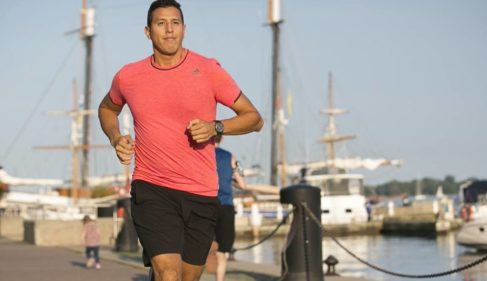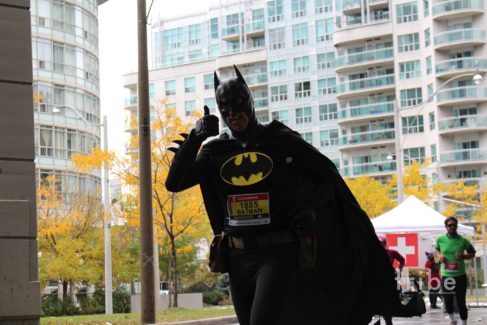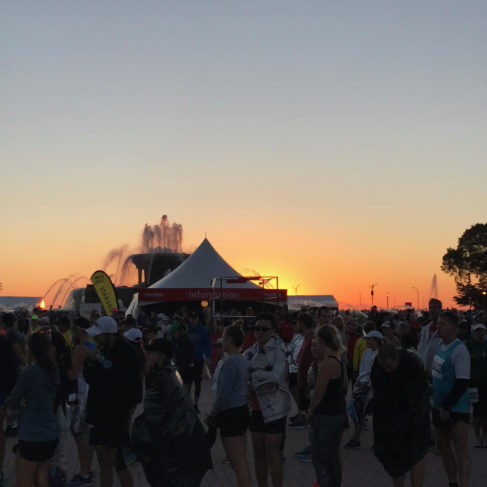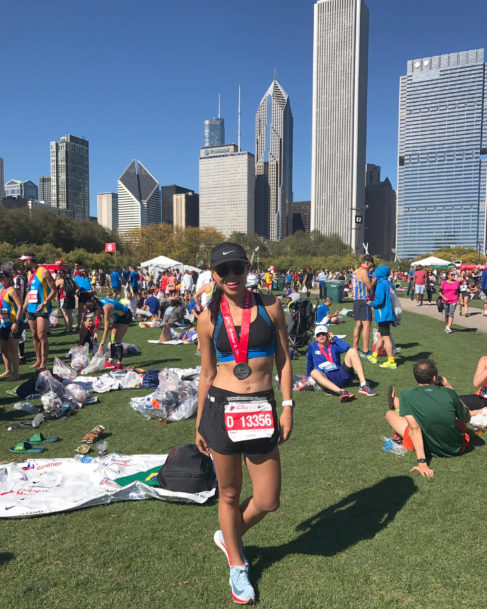Why I Run, and What I Want for Running, by Jean-Paul Bedard and Krista DuChene
Krista DuChene is a Canadian Olympian and the second fastest female marathon runner of all-time. She once ran a half marathon in Montreal on a broken femur, and still took third. Jean-Paul Bedard is an activist and an ultra-runner, who will be running 6 in the SIX this weekend at the Toronto Scotiabank Waterfront Marathon, in order to raise funds and awareness for those impacted by sexual violence. His first of six marathons begin Friday morning. We brought the two Hall of Famers together for a discussion.
iRun: What’s your wish for running and runners in the new year? There’s so many of us, what should we be doing with our platform? My wish is that we have even more runners.
Krista: It’s a sport that requires very little investment with tremendous gain. Let’s aim for more sell-out events; for more in the 5 km road race or the 50 k trail run and everything in between; for more road closures during competitions; and for more off-road running adventures. Let’s make running more normal for everyone! To do this, let’s keep doing what we’re doing!
JP: One of the things I love about social media is that it takes running, a somewhat solitary and individualistic activity, and transforms it into a community or social practice. I think that for our sport to continue to flourish, shoe and apparel companies and to an even greater degree, race directors, will need to direct more resources to the so-called ‘middle’ and ‘back-of-the-pack’ runners. I believe that iRun has been a leader in this movement by profiling making a conscious decision to profile ‘the everyday runner’ right along side the ‘elites’.
iRun: How do you guys feel when people applaud you and call you a hero?
Krista: I feel honoured. I take my role as a Canadian, marathoner, Olympian, community member, parent, dietitian, and woman seriously. I have fun but am also very deliberate about how I communicate. I aim to be authentic, honest and open about my difficult trials and wonderful blessings. I strive to deliver appropriate messages when public speaking, writing, or posting on social media. I am aware that I can make a big difference in someone’s life, even with one simple comment. And I can only hope that I make a positive difference. While it’s an honour, it can also be a struggle particularly when it’s a time that I just want to put my head down, avoid the chit-chat, and just focus on getting to work.
JP: That’s a question I get asked a lot, and it’s one that I continue to struggle with. The the downside of having a public profile is that your life becomes ‘very public’, and because of that, my struggles with drug and alcohol addiction, and the childhood trauma I experienced, have become interwoven into any of the successes I’ve had in sport. I’ve never thought of myself as a ‘hero’, yet I do acknowledge that many people do look up to me. But what I believe is happening here is that people see themselves in me. They see their own struggles in my struggles. They see their own vulnerability in my vulnerability. But most of all, they recognize their own ability to rise through adversity by witnessing the resilience of the human spirit in me.
iRun: You both obviously have a passion for sharing your stories, and more often than not, that involves making yourself vulnerable by being open and honest. How do you manage to navigate that space, while at the same time making sure you provide yourself the self-care needed to keep doing what you’re doing?
Krista: Making myself vulnerable by being open and honest can actually be one of the easiest things for me. I don’t need to put on an act or performance with the intention of motivating my audience; I just tell my story with authenticity. I aim to be real and am told I’m an inspiration so I feel successful in what I set out to do. In order to provide self-care, I’ve had to learn to say no. I can’t be everything to everyone all the time. If I need space or time off, I take it. And I don’t feel any need to justify it.
JP: As an athlete, I like to think of myself as strong and somewhat invisible, but the the truth is that in order to perform at the level I choose to, it requires that I continually push against the physical and mental limits of my endurance. And here is where I believe the running community can be instrumental in sustaining us when we, unfortunately, tumble from those great heights we set for ourselves. To me, running has become a metaphor for my life—it’s the canvas on which I get to paint whatever story is unfolding in me that day or at that moment. I feel passionate about sharing so much of my story because I wholeheartedly believe that those ‘vulnerable pieces’ of me are actually the strongest and most beautiful parts of me. I’ve been very open about the struggles I’ve faced, and to a large degree continue to deal with, because I am passionate about breaking the silence that leads to all that negative self talk that rattles around our mind telling us, “I’m not good enough. I can’t do this.” So for me, self-care has a lot to do with staying connected with my community; that’s where I find my inspiration to take the “I can’t” and transform it into “Hell ya… I can!”
iRun: You’ve spoken openly about the importance of “faith” in your life outside of athletics, but what I’m interested in knowing is whether or not that spiritual grounding has come into your running practice?
Krista: My running is 100% about my Christian faith. I feel I’m here for a reason, God’s reason to use my life in His way. I am not defined by my performance, poor or spectacular, rather by my Christianity. It’s helped me out of my lowest lows and kept me grounded in my highest highs. Eric Liddell “I believe God made me for a purpose, but he also made me fast! And when I run I feel his pleasure.”
JP: As an endurance athlete, you quickly understand that no matter how much preparation and training you put in, there comes a time, either in the late stages of race or in the midst of a long training session, when you have come to the ‘edge of yourself’. It’s there you discover what sits in your heart and propels you to keep moving forward. There’s no doubt that this a moment of truth, and it’s in the silence of this moment that my faith speaks loudest to me. When you strip away everything else, you are left with yourself; and that space can be a very uncomfortable place to be. For me, faith reminds me of how intricately we are all connected. I attend church a few times a week because I find great solace and a feeling of rejuvenation when I’m closer to my faith. When it comes to faith intersecting with my running, I’m reminded of the tattoo I have on my arm––Romans 8:18. It’s one of my favourite verses from the Bible: “Our present suffering can not compare to the glory that will be revealed within us.” As a long distance runner, I’m very acquainted with suffering, and I’m equally aware that on the other side of suffering comes much joy—the finisher’s medal and the banana!
iRun: Like actors and performers, elite athletes are compelled to confront the realities of aging, not in private, but rather in a public forum. How are you dealing with the aging process, and is it something you’re embracing or pushing back against?
Krista: I am fully embracing the reality of ageing! My goal is to do it gracefully. I won’t fight it nor think my fastest times are still ahead of me, even though there could be some PB’s (personal bests) ahead! I will continue to appreciate my previous successes, and also leave room for better performances. During this season of not running a fall marathon, I am preparing for and engaging in those activities I previously set aside due to the demands of training and racing. More of my time and energy is now spent coaching, public speaking, writing, and practising as a Registered Dietitian. I’ve deliberately taken this off-season to better establish myself in these fields as I will eventually spend more time in them than competing as an elite marathoner. I will always run and keep active in the running community while I continue to adjust my goal times. Competing as a master is a good way to transition and “age”! And I have retirement bucket list items: ultra on the trails, ironman, etc.! My only dilemma is what to do about my slowly greying hair. To dye or not to dye? I’ll never forget, as the oldest member of Canada’s Athletics (track and field) team, plucking the few greys I had just before walking in the Closing Ceremony at the 2016 Olympic Games.
JP: What do they say: “I’ll take growing old any day because the alternative is not much of an alternative.” I’m at the point of my life where I can still perform the way I used to, but now it takes a lot more work to prepare and recover. Like many of you reading this, I’m an endorphin junkie, so as long as I get my daily fix, I’m a happy camper. I’ve approached aging in my running practice with the same philosophy I use when I’m running up a long, steep hill in marathon or ultra. The trick is not to speed up on that hill, but to maintain the same perceived effort, and typically that means slowing the pace and trying to maintain the same heart rate. And that’s what I find myself doing as I’m aging into sport. I get the same endorphin rush, but now that happens at a slower pace. One of the amazing gifts of becoming an older, or ‘masters’ athlete is that you now are graced with the opportunity to mentor younger athletes or those just entering our sport.












 The day prior to the race was very humid and muggy, but thankfully it cooled down significantly by nighttime. In the early morning, temperature was about 14 Celsius and we were greeted with a glorious sunrise beyond the Buckingham Fountain as we checked our bags and went for one last bathroom break. The weather would remain relatively cool for about two hours but then the temperature rose significantly, and was at least about 26C by the time I finished the race around 11:30, and in the latter part of the race, there were more portions of the route not shaded by tall buildings.
The day prior to the race was very humid and muggy, but thankfully it cooled down significantly by nighttime. In the early morning, temperature was about 14 Celsius and we were greeted with a glorious sunrise beyond the Buckingham Fountain as we checked our bags and went for one last bathroom break. The weather would remain relatively cool for about two hours but then the temperature rose significantly, and was at least about 26C by the time I finished the race around 11:30, and in the latter part of the race, there were more portions of the route not shaded by tall buildings. The relatively flat course makes for a fast course, and most of the bridges has the metal grate surface carpeted. The one moderate incline in the last few hundred metres to the finish line proved to be a small challenge. I appreciated the frequent kilometre markers and the big water/Gatorade stations and the cheerful volunteers. Several sprinklers and a few sponge stations were along the route, which came in handy once the sun was out in full force, and chafe not–several stations had Vaseline for runners to slather on.
The relatively flat course makes for a fast course, and most of the bridges has the metal grate surface carpeted. The one moderate incline in the last few hundred metres to the finish line proved to be a small challenge. I appreciated the frequent kilometre markers and the big water/Gatorade stations and the cheerful volunteers. Several sprinklers and a few sponge stations were along the route, which came in handy once the sun was out in full force, and chafe not–several stations had Vaseline for runners to slather on. tIn the end, we ran our second fastest marathon here (and my marathon PB is also in Chicago three years ago), so the flat, festive course is a nice fast one for those looking to PB or BQ.
tIn the end, we ran our second fastest marathon here (and my marathon PB is also in Chicago three years ago), so the flat, festive course is a nice fast one for those looking to PB or BQ.



 Our Magazine
Our Magazine
